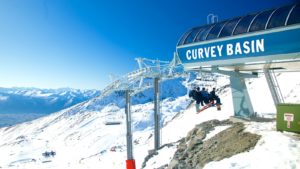It’s no secret: ski vacations are expensive. But, if you’re clever, you can budget your money in little ways, which adds up to big savings. Here’s how to save money on a ski vacation
1) Score discount lift tickets. Lift tickets can cost upwards of $80 a day at some ski resorts. Don’t shell out full price at the window. Instead, check out discount lift ticket sites like Skicoupons.com or Liftopia.
2) Bring your lunch. This is a point that can’t be repeated enough: pack a brown bag lunch, and you’ll end up saving a ton. Ski resorts are like movie theaters in that you pay a ridiculous amount of money for food that’s most likely, just okay. Even if you’re lucky enough to ski at a resort with a top-notch cafeteria, chances are you’ll end up sheepishly walking away from the cash register wondering how you just dropped $20 on a burger, fries and soda. Multiply that number by your spouse and your children, and it adds up quick. Bring a bagged lunch, though, and you could save upwards of $50 a day.
3) Stay hydrated without spending money. A bottle of water at a ski resort usually costs $4. You can’t skimp on water – especially if you’re skiing at high altitude – but it also doesn’t make sense to spend that much on a bottle you’ll probably gulp down in two minutes. Pack a small refillable canteen, or even better, wear a Camelbak, so you can stay hydrated while saving money.
4) Come prepared. Make sure you have all your accessories on hand – goggles, gloves, gaiter – before you make the trek to the ski resort. Resorts are clever in making all of this available to you in overpriced resort stores, should something slip your mind, but you’ll be shelling out a lot more than you would normally. You can also save money by bringing your own sunscreen, chapstick and hand warmers.
5) Avoid peak season. Ski resorts rev into high gear from Christmas through President’s Week in February. Inevitably, vacations during peak season are going to be more expensive. If you can book closer to the “shoulder seasons” – fall and spring – you’ll save a lot of lodging, lift tickets and even food and drinks.
6) Plan ahead. Sure, booking a last-minute, spontaneous ski vacation will always be a thrill, but you’ll save money if you plan ahead and make your reservations as early as possible. Booking about two to three months ahead of time gives you enough leeway to scout out the best deals.
7) Travel mid-week. Everything’s cheaper when you leave out the weekend – flights, hotels, even lift tickets. A Monday-Thursday vacation would give you two solid days of skiing, and you can even looking into tacking on one weekend day (Sunday or Friday) to extend your vacation while still keeping it economical.
8) Avoid vacation weeks. Obviously, ski resorts are busiest during school vacation weeks. If you can avoid these time periods, you’ll save money and save time (after all, vacation weeks draw families, who crowd up the slopes and fill out the lift lines). Check the local school schedule of the resort your traveling to to see which weeks schools are out. Pay attention to special events, too. For example, the week of the Sundance Film Festival in Park City, Utah is not a good time for ordinary skiers looking for discounts to visit.
9) Be mindful of baggage costs. When booking flights, most people just scan for the cheapest airfare. But another thing to keep in mind is whether or not the airline allows you to check your skis and boots for free. For example, Southwest allows free checked ski bags, whereas other airlines charges fees.
10) Pack light. Don’t get buried in oversized luggage fees, which can be more than $100. This applies to both ski bags and suitcases, so make sure you do your research and figure out the maximum dimensions of your luggage as well as the maximum weight.
11) Peruse Collective Buys. You can use discount sites to book a budget ski vacation, scoring deals not just on hotels, but on food, too.
12) Look beyond the hotel. Hotels, and on-site lodging especially, can be a lot more costly than condos or houseshares, especially if you plan on staying for an extended period of time. Renting directly from owners, such as through AirBNB, is another way to save money.
13) Look into lodging & lift ticket combination deals. If staying at a resort hotel or an on-site condo is a priority for you – after all, it is more convenient – make sure to inquire about lift ticket deals. Some hotels will offer lodging packages that include lift tickets and discounted meals.
14) Take advantage of free mountain tours. Don’t pay for a guide if you don’t have to. Many resorts offer guided tours by mountain ambassadors, free of charge. It’s a great way to make the most of the mountain, without spending a penny.
15) Rent equipment off-site. Everything’s more expensive at a ski resort: food, rentals, gear. Make sure you compare the prices of local ski shops with those of the resort’s rental store, but don’t forget to factor in special packages the resort might offer. For example, if you can find an all-inclusive deal that combines lessons, lift tickets and rentals, it may be more economical. Take a few minutes to do the math, and you may be pleasantly surprised with the outcome.
16) Go to happy hour. Avoid splurging at the bar and hit up the aprés-ski happy hour, where both food and drinks are usually discounted. Plus, you’re bound to encounter a lively atmosphere if you stop in just after the lifts close.
17) Hit up the grocery store. Make it a priority to book accommodations that include, at least, a kitchenette. With a refrigerator and microwave, you can have breakfast, lunch and dinner covered. Even better, if you book a condo that has a kitchen, you can save even more money on food, leaving you with some extra cash to splurge on a nice dinner out at the end of your trip.
18) Take advantage of kids-ski-free deals. Many resorts offer deals in which kids ski free upon purchase of an adult lift ticket. But, before banking on the deal, be aware that the age varies – some resorts qualify a kid as anyone under 12, while others set the limit at 6.
19) If you have to, take turns in the lodge. If the resort you’re at doesn’t have a kids-ski-free program, save money on child care one day by taking turns in the lodge. Some parents have been known to purchase one lift ticket and have mom and dad switch off between skiing and nannying.
20) Buy the appropriate lift ticket. Most ski resorts don’t necessarily advertise these deals, but if you’re a senior, student, or member of the military, be sure to inquire about discounted rates. Also keep in mind the amount of time that you’re going to be on the mountain – for example, if you had a late night, save money and buy a half-day ticket, or even a night skiing ticket, if it’s available.
21) Look into lift ticket packages. If you’re going to be skiing for a number of days at the same ski resort, don’t buy a ticket at the window each day. You can save time and money by purchasing a three-day pass, for example, than buying an individual ticket each morning.
22) Consider package deals. You may be able to save money by linking together lodging and airfare through websites like Kayak and Expedia. Ski-specific travel sites, like SnowPak and Snowventures can also offer good deals.
23) Compare season pass rates with ticket rates. If you’re taking a long vacation – say, if you plan to spend more than 10 days skiing – you may be surprised to find that buying a low-level season pass or season discount card will be cheaper than buying lift tickets. It varies hugely depending on what resort you’re skiing, but, it’s definitely something to look into.
24) Pack smart. The last thing you want to do is buy gear at the resort! Check the weather the day before you leave so you can plan accordingly and bring the appropriate gear.













